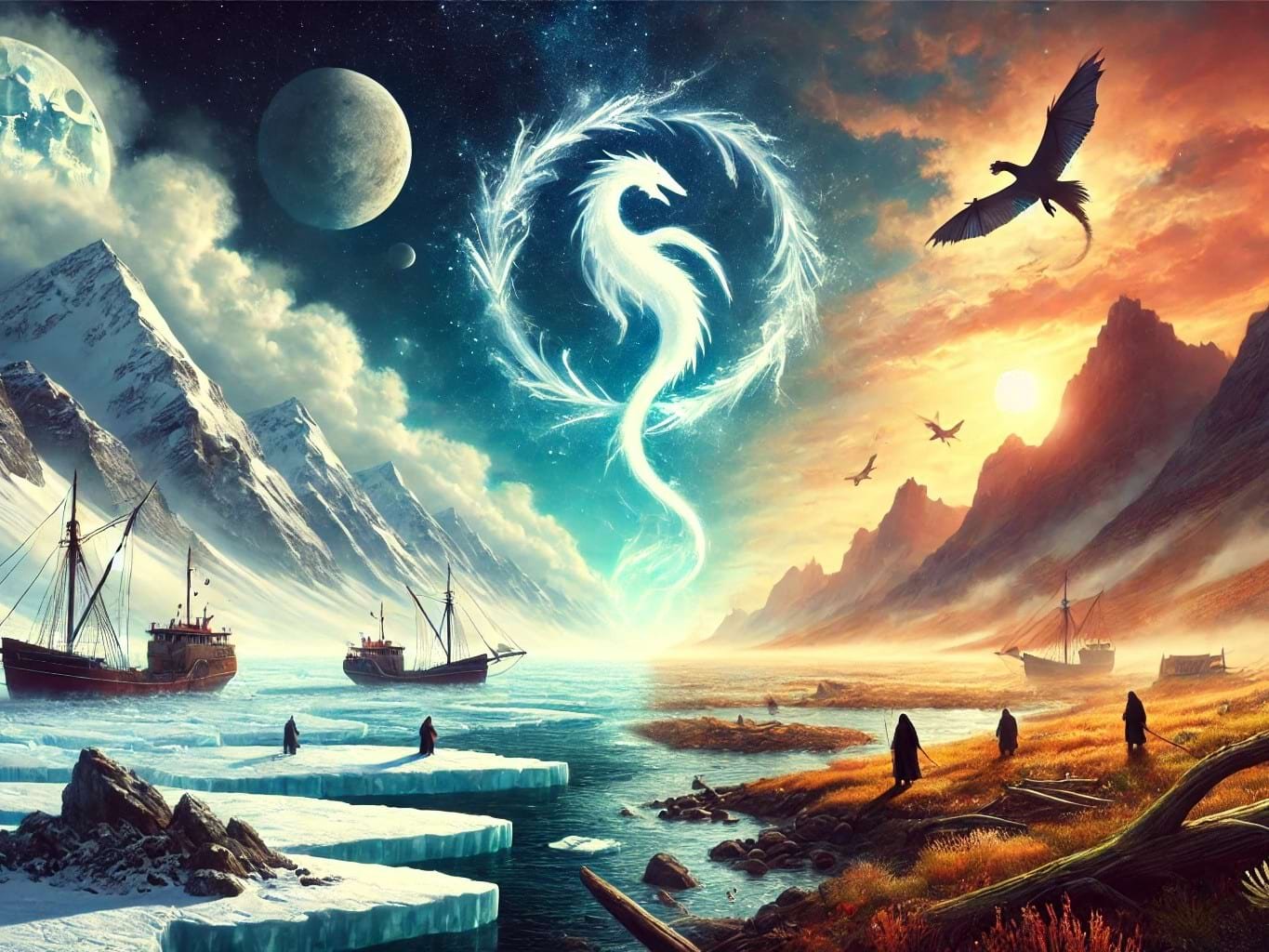Have you ever revisited a fairytale you loved as a child, only to find it wasn’t quite the same? The story is familiar, but somehow, there’s so much more to it—meanings that seem to have been waiting for you to catch up. Isn’t it wonderful how stories can grow with us, and we with them?
Here’s a mini-fairytale for you. If you’ve got a moment—maybe with a cup of coffee or tea in hand—settle in and step onto an island where ancient divisions, forgotten wisdom, and an unexpected question lingers in the salt-laden air. I hope you enjoy it.
Table of contents
A 5-minute story of desert and sea
Once upon a time, on an island far across the sea, there lived two peoples: the Sea People in the north and the Desert People in the south. The island was vast, yet entirely isolated, surrounded by endless waters. Legends whispered that their ancestors had arrived by boat, but no one truly knew from where.
Between them stood a mighty mountain range, so tall that its peaks were lost in the clouds. A single narrow pass wound through the mountains, but it was treacherous, and few dared to cross. In truth, neither people thought it necessary—for their lives were hard enough, each struggling to survive in their own extreme lands.
In the north, winters were harsh. The sea froze, and nothing could grow. But the Sea People had learned to fish in the deep waters and preserve their catch, salting and drying enough food to last the cold months.
In the south, summers were scorching. The sun burned the land, and nothing could grow. But the Desert People had learned to hunt in the mountains and dig deep wells to find hidden water, storing food to survive the relentless heat.
And so, both peoples thrived in their own way.
The serpent and the dragon
The Sea People worshipped the great Sea Dragon, guardian of the deep. The Desert People revered the mighty Desert Serpent, ruler of the sands. Every day, each would kneel and offer gratitude to the sky—the Desert People at dawn, before the sun grew fierce, and the Sea People at dusk, when the winds were calm.
Long ago, before the two had become separate, there was a great Seer who spoke of a single force beyond their understanding. He said this mystery was faceless and formless, yet omnipresent, omniscient, and omnipotent, as it had spawned their island and sparked their spirits. It could not be named or imagined, for any image would be false.
Some whispered that the Seer had once called it Tao, but then he had also said, “The Tao that can be told is not the real Tao.” This made no sense to the people: How can we deny a name to something so mighty and colossal? So they simply called it Omni and trusted in its mystery.
The Seer warned them never to carve statues or paint images of this unfathomable force, for doing so would lead to misunderstanding. At the time, they obeyed. No face, no form, so no images—that seemed reasonable. And for many years, they lived in harmony.
The passing of the Seer
But when the Seer passed away, life grew harder. The people quarreled. Should they fish or hunt? Should they live by the sea or in the sands? Their customs and ways grew different. They distrusted one another. Fights broke out. At last, they agreed to seal the mountain pass.
With the pass closed, the wars ceased, and both peoples were safe once more. But in their isolation, they grew apart. No longer one people, they became two nations. And in their fear of hunger and hardship, their understanding of Omni changed.
The Sea People shaped Omni into the great Sea Dragon, lord of the waves. The Desert People saw Omni as the mighty Desert Serpent, ruler of the dunes. And soon, they began to argue: Whose god is stronger? If they were to fight, who would win?
Superstition or faith?
As the years passed, belief wavered. The Sea People grew skeptical. “The dragon is but a story,” they said. “We fish, we dry, we store—this is what sustains us.” And so, they abandoned their prayers.
But the Desert People still believed in the Serpent. When, at last, the mountain pass was reopened and the two peoples met again, the Desert People spoke of their faith. The Sea People laughed. “You are superstitious,” they said. “There is nothing beyond what we can see.”
Yet the Desert People answered, “There are things beyond our understanding, forces beyond our control. Your nets can catch fish but not the twine that wove them.”
And for a time, their faith was so strong that it nearly overtook the Sea People. The Desert People tore down the Sea Dragon statues and replaced them with the Desert Serpent. The Sea People didn’t really care because it was all superstition anyway.
Until one day, a child spoke up: “Perhaps the Sea Dragon and the Desert Serpent do not exist quite literally, but can we not all agree—there will always be a mystery? So if we want to talk about it, we have to give it a name?”
It was a peculiar and precocious thing to say. But the people paused. They looked at one another. And then, they remembered the words of the Seer, long ago.
Omni had never been a dragon. It had never been a serpent. It was beyond all names, beyond all images. Vivid but ineffable, it had been there all along, in the fish of the sea, in the wells of the desert, in the wind between them.
And so, they stopped marring cultural heritage and let go of their quarrels. They reopened the mountain pass and walked freely once more.
For at last, they understood: they were never two islands, but one.
And they lived in peace ever after.
You can support Marcel’s work , find gifts, and amp up your style at Marcel’s Booktique.
His books—in paper, pixel, and audio—can also be found at Amazon and other select retailers.
Looking for mindful & funny spiritual gifts, gear, deco, or gadgets? Why not check out the affordable Amazon Merch custom designs by Simply Nondual!
Share this article:




